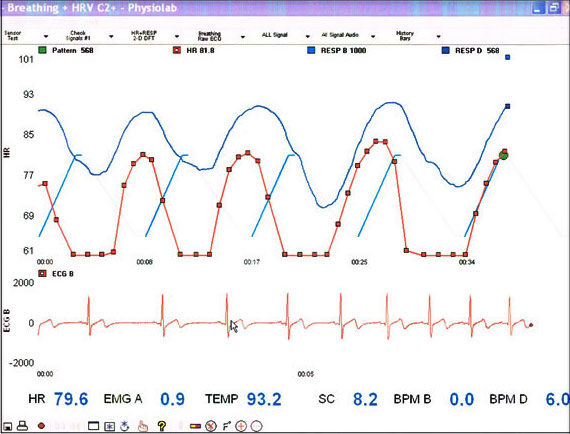Biofeedback
What is Biofeedback?
Biofeedback is a process that teaches people how to regulate their physiology. Because we are frequently unaware of the way our nervous system functions, biofeedback allows us to observe our physiology in real time and train our bodies to make changes that decrease symptoms and enhance health and performance.

Computer Readings of the Autonomic Nervous System - Top: blue lines = breathing pattern (inhale, exhale); red lines and dots = heart rate (increase, decrease) Middle: red lines = heart beat (EKG or ECG); Bottom Numbers: HR = heart rate; EMG = muscle tension; Temp = skin temperature; SC = skin conductance; BPM = breath per minute.
How Does Biofeedback Work?
The various aspects of the nervous system operate much like instrumentalists in an orchestra who learn their parts individually and then collaborate with others to create more complex music. The term "Biofeedback" refers to the regulation of the autonomic nervous system that controls such functions as breathing, heart rate and blood pressure. The term "Neurotherapy" refers to the regulation of the central nervous system that controls brainwave function.
Through repetition and therapeutic exploration of thoughts and emotions, clients are taught how to restore physiological balance and create new states of consciousness similar to the manner in which learning to ride a bicycle eventually becomes natural and automatic.
Process of Biofeedback
In Biofeedback, sensors are put around the waist, fingers and wrists that measure heart rate, skin conductance, muscle tension, breathing and skin temperature. These readings are displayed on a computer monitor in auditory, visual or numeric form so that clients can watch the changes in their physiology as they talk about issues or practice relaxation skills.
In Neurotherapy, electrodes are placed on the head and clients are taught how to move images on a computer monitor with their brainwaves. Dr. Lemare-Calaba guides clients toward therapeutic brainwaves states that she has identified by analyzing their Quantitative EEG Brain Map (QEEG Brain Mapping) and the computer provides auditory and visual feedback each time the goal is achieved.
Biofeedback and Neurotherapy are frequently combined once individual skills have been mastered. For instance, clients who can keep their breathing and heart rate steady may be asked to do so at the same time as they train their brainwaves in a Neurotherapy session.
Biofeedback for Couples and Families
Dr. Calaba specializes in Biofeedback for Couples and Families in which each person's nervous system is reflected on a separate computer monitor. This allows families to learn about each other and work toward open states of communication. It also helps people modify the reactivity of their nervous systems and see the impact of their words on others. (For instance, a father says something critical to his son. The son's skin conductance level escalates and mirrors back to the father a negative impact. )
Biofeedback is an easy, educational process that most people, particularly adolescents and children can enjoy.
